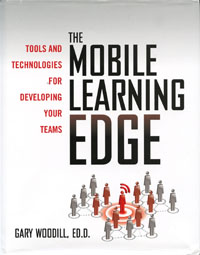Gary Woodill, senior analyst at Brandon Hall Research, has contributed a new book to the slowly growing library on mobile learning.
The Mobile Learning Edge seems intended for training managers and educators in the mainstream market, and for others who are new to or only just becoming aware of the potential of mobile technologies for learning. If you know someone who is trying to come to grips with the evolution of yet another disruptive technology and the associated disintermediation, this book may help them. Early adopters and others who are already making use of mobile devices to facilitate learning and to support performance will not gain much from it, other than a source of explanations that will help others get up to speed.

What’s in the book
The book's sub-title is “Tools and technologies for developing your teams.” In support of this, Woodill and two contributors offer ten chapters on:
-
the history of mobile learning,
-
an overview of the “mobile learning ecosystem,”
-
a summary of principles affecting mobile learning design,
-
learning-related applications of mobile technology (retrieving and gathering information),
-
various considerations of online learning,
-
a summary of learning, knowledge, and performance management related to mobile technology,
-
a guide to developing a future-oriented mobile learning strategy (contributed by David Fell),
-
a brief look at creating mobile learning content and experiences, and
-
a short section of advice on implementing and managing enterprise mobile learning (contributed by Sheryl Herle).
Eight chapters include case studies to illustrate some of the key point(s) discussed. Two appendices offer a brief list of resources and a lengthy bibliography. There is also an associated Web site (http://mobilelearningedge.com) that is intended to provide updated information about mobile learning technology.
Strengths
Woodill and his co-authors were certainly ambitious in the scope they addressed in their work. By necessity, this means that the treatment is more a survey than a detailed “how-to” guide. As such, in my opinion, it is going to be more useful to managers, particularly to managers who do not have an extensive background in instructional design (ID) or information and communications technology (ICT). It may also be useful to individuals who are new to ID.
Woodill provides somewhat simplified views of a number of ideas that are important to instructional design in general and to mobile learning in particular. For example, he offers seven principles about mobile learning for employee training; experienced instructional designers will recognize these as re-statements of familiar adult learning principles, but they may come as news to others who do not have such a background. Woodill also offers an analysis of the various provider groups in mobile learning; again, this could be helpful to managers who must deal with a new set of vendors and service providers.
Consistent with the survey treatment, Woodill offers in the first chapters a fast walkthrough of a wide variety of technologies related to mobile learning. These range from text messaging to QR tags, USB storage devices to UGC (user-generated content). It’s quite a collection. It’s hard to imagine a manager actually sitting down to read all the way through this, let alone anyone who is already immersed in technology and social media. But I can see how these short explanations would be useful in situations in which it is necessary to explain concisely to decision-makers how QR codes work, or what Knowledge Management, Learning Management, and Learning Content Management Systems are.
Some issues
I don’t think I would just hand this book to the boss. It’s really not organized to make efficient use of a busy person’s time, and the style is not exactly engaging. Woodill spends a lot of time reviewing history in many of the chapters. For example, the first ten pages of Chapter 1 address the history of computing, the evolution of mobile computing devices, and the growth of the mobile learning concept from 2001 to 2009 – year by year. If a professor used The Mobile Learning Edge as a textbook, this might be appropriate, but for practical purposes, the intended audience is likely to become very impatient. An executive usually just wants to know what time it is, not all about the history of watchmaking.
Much of the referenced research is two years old or older. It seemed to me that the discussion gave scant attention to the related, simultaneous, and important growth of social media. There are lists of Web sites, software, and devices that are useful for creating and editing mobile learning, but these are not well-organized within the book nor is there much that will help the reader get started with development.
Summary
The Mobile Learning Edge is a book that probably belongs on your bookshelf if you are new to the idea of mobile learning AND if you are a manager of training, an educator in a more traditional setting, or if you are an instructor or instructional designer. If you are already familiar with or engaged in mobile learning, it’s going to be less useful to you, although you may find some of the explanations handy when you are looking for support. I would recommend using “sticky notes” as flags to mark the particular sections containing the information you want to find quickly. I would also not recommend giving the book to your boss with the suggestion that he or she read it (it’s not a page-turner).
Bibliographic information
Woodill, Gary, Ed.D., et al. The Mobile Learning Edge: Tools and technologies for developing your teams. (2010) New York: McGraw-Hill. 269 pages. ISBN 978-0-07-173676-3. USD $29.95 (hard copy), USD $14.22 (Kindle).



